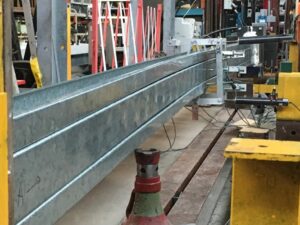Summary
The building industry is seeing a rapid uptake of joining two or more cold-formed steel sections to form large built-up sections with high carrying capacities. The joining consists of screws, or similar fasteners, placed intermittently along the member. The ease of joining encourages innovation in forming versatile new built-up section shapes in expanding areas of application. The purpose of the project is to provide guidelines and numerical tools for the efficient structural design of built-up sections through experimental and theoretical research, studying the new failure modes pertaining to built-up sections, the increase in strength achievable from composite action and the optimum arrangement of fasteners.
This Project is supported by the ARC Discovery Project DP140104464.
Chief investigators
- Prof Kim Rasmussen
- Associate Prof Hao Zhang
- Dr Mani Khezri
- Prof Ben Schafer
PhD students and graduates:
- Dr Dang Khoa Phan
- Ms Mandana Abbasi
- Ms Di Ma

Project outcomes
The project includes analytical, numerical and experimental studies. Highlights of these studies include:
Analytical studies
A complete theory has been set out for the linear and buckling analyses of built-up sections. The theory accounts for the flexibility and arbitrary arrangement of fasteners, including end fastener groups, and considers both flexure and torsion. Equations are derived for determining the optimal location of fasteners as well as the effective flexural, torsional and warping rigidities of built-up sections, accounting for partial composite action at fastener points. The torsion analysis considers both open and closed cross-sections and produces explicit equations for calculating the significant additional torsional rigidity achievable by introducing closed loops in the cross-section.
Equations are also derived for the flexural buckling of built-up sections columns for a range of support conditions and fastener arrangements. It is shown that buckling equations used in existing specifications for built-up cold-formed steel structural members may be highly inaccurate, especially when a relatively small number of fastener points are used.
Experimental studies
Tests have been performed on built-up sections failing in local, distortional and/or global (member) buckling modes as well as interaction between these modes. The cross-sections comprise 2, 3 or 4 component C-sections in various arrangements producing singly- and doubly-symmetric cross-sections with or without closed loops. Columns were tested at various lengths between pinned-ends leading to failure in flexural and flexural-torsional modes. Braced and unbraced beams were also tested over a range of lengths to establish beam buckling curves.
Additional tests on fasteners in shear have provided force-displacement relationships including stiffness and strength for screws and bolts. Separate tests were performed to determine experimentally the flexural and torsional rigidity of built-up sections.
Numerical studies
A novel Compound Finite Strip Method has been devised to calculate the elastic buckling load of built-up sections accounting for the effect of discrete fasteners and their flexibility. The Method connects the component sections at fastener points and caters for arbitrary distributions of fasteners longitudinally and cross-sectionally. It calculates the increase in buckling load resulting from the change in buckling mode caused by discrete fasteners.
Extensive finite element analyses were also performed to obtain additional ultimate strength data for proposing efficient design equations for the local, distortional and global buckling strength of built-up cold-formed steel members. The finite element models were first calibrated against the experimental results and subsequently used for parametric studies of built-up columns and beams covering a range of built-up cross-sections and member lengths; the main focus being on sections with three or more component sections.

Publications
- M. Khezri, M. Abbasi and K.J.R. Rasmussen, “A combined meshfree/finite strip method for analysis of plates with perforations and cracks”, Thin-Walled Structures, 2017, Vol. 111, 113-125.
- M. Khezri, M. Gharib and K.J.R. Rasmussen, “A unified approach to meshless analysis of thin to moderately thick plates based on a shear-locking-free Mindlin theory formulation”, Thin-Walled Structures, 2018, Vol. 124, 161-179.
- D.C. Fratamico, S. Torabian, X. Zhao, K.J.R. Rasmussen and B.W. Schafer, “Experiments on the global buckling and collapse of built-up cold-formed steel columns”, Journal of Constructional Steel Research, 2018, Vol. 144, 65-80.
- D.C. Fratamico, S. Torabian, X. Zhao, K.J.R. Rasmussen and B.W. Schafer, “Experimental study on the composite action in sheathed and bare built-up cold-formed steel columns”, Thin-Walled Structures, 2018, Vol. 127, 290-305.
- M. Abbasi, M. Khezri, K.J.R. Rasmussen and B.W. Schafer, “Elastic buckling analysis of cold-formed steel built-up sections with discrete fasteners using the compound strip method”, Thin-Walled Structures, 2018, Vol. 124, 58-71.
- M. Khezri and K.J.R. Rasmussen, “An energy-based approach to buckling modal decomposition of thin-walled members with arbitrary cross sections”, Part 1: Derivation, Thin-Walled Structures, 2019, Vol. 138, 496-517.
- M. Khezri and K.J.R. Rasmussen, “An energy-based approach to buckling modal decomposition of thin-walled members with arbitrary cross-sections, Part 2: Modified global torsion modes, examples”, Thin-Walled Structures, 2019, Vol. 138, 518-531.
- D. K. Phan and K.J.R. Rasmussen, “Flexural rigidity of cold-formed steel built-up members”, Thin-Walled Structures, 2019, Vol. 140, 438-449.
- K.J.R. Rasmussen, M. Khezri, B.W. Schafer and H. Zhang, “The mechanics of built-up cold-formed steel members”, Thin-walled Structures, 2020, Vol. 154, doi.org/10.1016/j.tws.2020.106756.
- D.K. Phan, B.W. Schafer and K.J.R. Rasmussen, “Tests and design of built-up section columns”, Journal of Constructional Steel Research, 2021, Vol. 181, doi.org/10.1016/j.jcsr.2021.106619.
- D.K. Phan, B.W. Schafer and K.J.R. Rasmussen, “Numerical investigation of the strength and design of cold-formed steel built-up columns”, Journal of Constructional Steel Research, 2022, Vol. 193, doi.org/10.1016/j.jcsr.2022.107276.